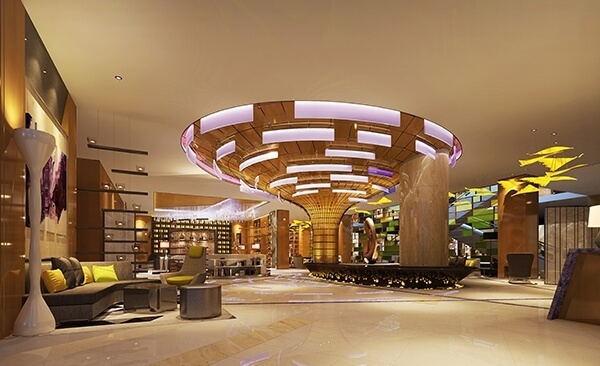
Hotel space is an important part of living space, and its lighting design is even more important. Good hotel lighting design can help illuminate the brand value, create a different stay experience, and bring unimaginable economic benefits to the hotel.
The lighting needs of different functional areas of the hotel are different, and the lighting design concerns should be different.

1. Hotel lobby
The hotel lobby is the hub for guests to enter and exit the hotel, and is also an important place to show the hotel’s grade and attract guests. It is mainly composed of functional areas such as reception hall, service desk, and guest rest area, with clear layout.
The reception hall mainly uses basic lighting. Due to the high height of the lobby of the general hotel, the lobby is often equipped with large chandeliers or lanterns as the main lighting at the top to reflect the style and grade of the hotel; the service desk is the first window of service communication, it occupies The most important location in the lobby. In terms of regional functions, in order to meet the needs of writing and communication, its illuminance requirements are often higher than other areas in the lobby; the guest lounge area provides a temporary communication rest place for residents and visitors. Due to the privacy of the use of functions, the rest area The illumination should not be too high, and attention should be paid to the integration with the surrounding environment.

2. Hotel rooms
As a temporary home for guests, hotel rooms should naturally have some functional modules of home: living room, bedroom, study bathroom, etc., to create an atmosphere that makes people feel cordial, comfortable and relaxing. General guest room comfort determines the level of hotel experience!
The room lighting design should choose warm colors, the color temperature should be about 3200K, not too bright, it is best to create a warm and comfortable environment, so that customers can relax and rest. Mixed lighting design can be used in the writing area to meet the requirements of writing illuminance; in the washing area, mirror reflections caused by lighting should be avoided.

3. Hotel corridor
The corridors of hotel guest rooms have simple spatial layout and satisfy traffic. Generally, they are fully enclosed or semi-enclosed. The narrow space will bring a sense of psychological restraint, boredom and fear to the people in the corridor. Therefore, corridor lighting should choose lighting and color temperature that make guests feel safe and warm, such as line-mounted light sources or downlights, wall lights and other lamps that can produce discontinuous spots.

4. Hotel dining area
The hotel’s dining area is an open space, used to socialize and enjoy food, and is also the main income-generating area of the hotel. Most restaurants will be divided by style, and the lighting layout of Chinese restaurants will be different from Western ones.
Chinese restaurants are often used for business catering or formal banquets. Therefore, the lighting in Chinese restaurants must not only have a high overall illuminance, but also maintain uniform illuminance, and try to avoid excessive brightness differences; Western restaurants are often used for informal For business dining or casual dining, the indoor lighting design generally creates an emotional atmosphere, and the lighting method is mainly based on a large number of accent lighting and decorative lighting. Whether it is a Chinese restaurant or a western restaurant, the color of the space should be warm and the color temperature should be around 3000K.
Lighting design for hotel indoor spaces is an effective way to improve the hotel’s quality and economic benefits. The design must consider practicality, safety, economy, and artistry, combined with consumers’ physiological and psychological factors, and choose appropriate lighting methods and The light source can create a good indoor light environment.
